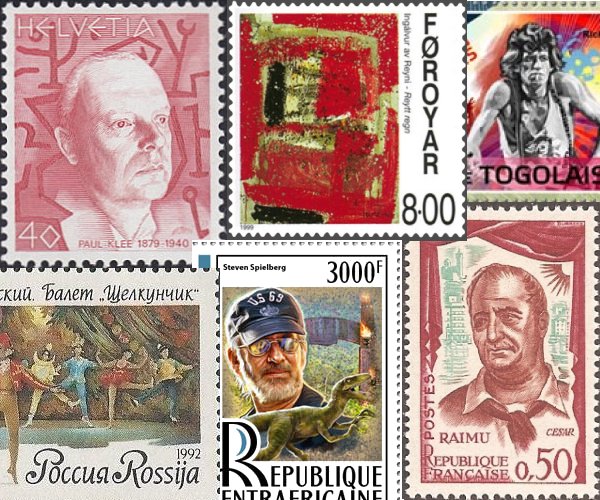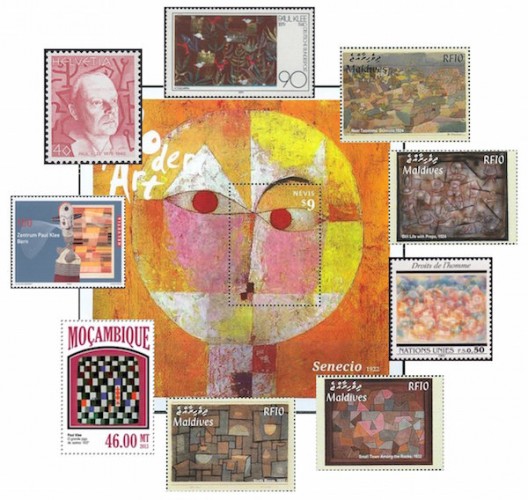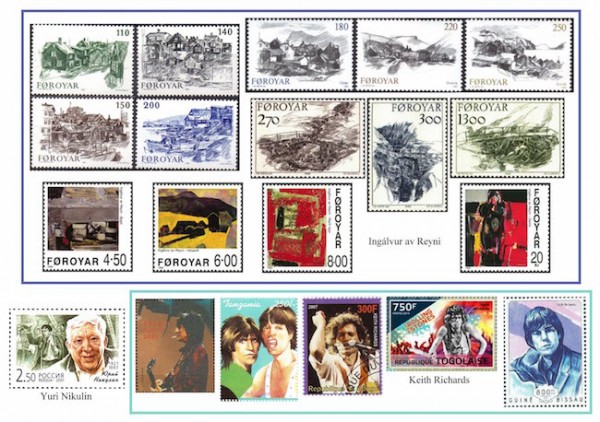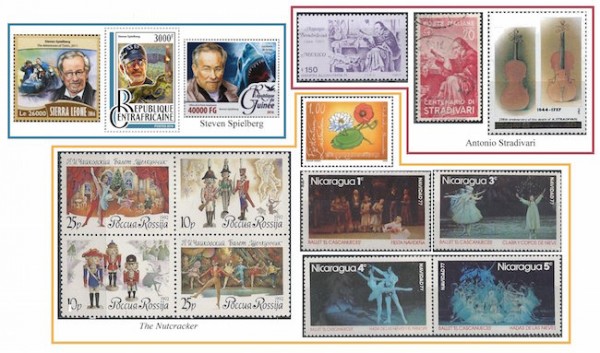The Arts on Stamps of the World — December 18
An Arts Fuse regular feature: the arts on stamps of the world.

By Doug Briscoe
December 18 is the birthday of Paul Klee (Betty Grable, Keith Richards, and Steven Spielberg are on the docket, too) and the death date of Antonio Stradivari. It’s also the 125th anniversary of Tchaikovsky’s Nutcracker. And there’s no stamp for him, but the fine American actor, author, and civil rights activist Ossie Davis was born a hundred years ago today. He died on February 4, 2005. The British short story writer Hector Hugh Munro (18 December 1870 – 14 November 1916), better known as Saki, has no philatelic commemoration either.

Paul Klee (18 December 1879 – 29 June 1940) might have had a career as a violinist. His parents were musicians, and Paul was accomplished enough by age eleven to be invited to join a professional group. Curiously enough, the main reason Klee turned from music to art was that he preferred the music of the past but wanted to belong to the art of the future. (He married a pianist, too.) Music has certainly responded abundantly. The late Gunther Schuller loved Klee’s work to the extent that he composed what is perhaps his best known score, Seven Studies on Themes of Paul Klee (1959-60), in appreciation. And Schuller was by no means alone: other prominent composers who have written music inspired by Klee include David Diamond (1958), Peter Maxwell Davies (1962), Harrison Birtwistle (1977), Edison Denisov (1985), Toru Takemitsu (1987), Leo Brouwer (1990), Tan Dun (1992), and Judith Weir (1992)! Only Klee’s native Switzerland has issued a stamp showing his face, but happily his paintings are more commonly seen. A sheet from Nevis offers his Senecio of 1922, and clockwise around the edges are Birds in Garden (c1910), Near Taormina and Still Life with Props (both 1924), Early Morning in Ro…1925, Small Town Among the Rocks and North Room (both 1932), and Überschach (Superchess, 1937), with the last stamp, another Swiss one and the most recent,combining two pieces: the painting I couldn’t identify, but the hand puppet is one that Klee made for his son Felix in 1925. Klee called it Big-Eared Clown (Breitohrclown). The stamp was issued at the time of the opening of the Zentrum Paul Klee in Bern in 2005.
Occasionally I like to include a person who, although not a proper artist, made some contribution to the world of art and who is deserving of our gratitude. One such is the remarkable Queen Christina of Sweden (18 December [O.S. 8 December] 1626 – 19 April 1689). Highly educated, unconventional (she wore men’s clothing, converted to Catholicism, and abdicated her throne), she founded the world’s oldest still functioning newspaper (1645) and was a patron of the arts who liked now and again to appear on the stage as an actress. Anyway, just thought I’d add a couple of stamps and a small paragraph for her.
The Dutch painter of ships and seascapes Willem van de Velde the Younger was baptized on this date in 1633. His father was a sea captain. At some point, probably in 1672-73, van de Velde relocated to England, where he died on 6 April 1707. Two of his paintings appear on stamps of The Central African Republic and the Republic of South Africa.

Charles Wesley (18 December 1707 – 29 March 1788), whose brother John founded the Methodist movement, was himself a leader of that movement and is credited with having written the words to more than 6,000 hymns, perhaps the most famous being “Hark! The Herald Angels Sing” (later set to music by Mendelssohn). Wesley also wrote some music, and his son Samuel and grandson Samuel Sebastian were both professional composers. In addition to the 2007 Irish stamp honoring Wesley, I found two stamps citing the aforementioned hymn.
December 18 is the birthday of American composer Edward MacDowell (1860 – January 23, 1908). One of his early teachers was the Venezuelan pianist and composer Teresa Carreño, whose birthday is next Friday. (She has two stamps.) While MacDowell was still a teenager, his family moved from his native New York City to Europe, where he attended the Paris Conservatory. Later, he moved on to Frankfurt and in 1884 married one of his American piano students. The couple returned to the US in 1888 and lived in Boston until 1896, when MacDowell took on a music professorship at Columbia University. He may have suffered from seasonal affective disorder and in his last years declined into a peaceful dementia. His wife Marian, who founded the MacDowell Colony in 1907, cared for him for the rest of his life. Funds for his care were publicly raised by a group of very distinguished figures, including former President Grover Cleveland, Andrew Carnegie, J. P. Morgan, and fellow composers Horatio Parker, Victor Herbert, Arthur Foote, and George Whitefield Chadwick. Marian MacDowell went on to lead the MacDowell Colony for more than 25 years. The composer is buried on the property.
The French actor popularly known as Raimu was born Jules Auguste Muraire on 18 December 1883. On the stage he was favored by Sacha Guitry. He sang baritone and took part in the première of Messager’s operetta Coups de roulis. (Messager’s birthday is at the end of this month.) Raimu is best remembered for his portrayal of the character César in Marcel Pagnol’s Marseilles trilogy (Marius, Fanny, and César, 1931-36). Raimu died of complications from anesthesia after a leg operation in 20 September 1946. Alec Guinness was among his admirers. The French stamp was issued in 1961 along with the one for Gérard Philipe we saw earlier this month.

Called the “Dean of Industrial Design”, Walter Dorwin Teague (December 18, 1883 – December 5, 1960), also an architect, was a vital force in American design. The frames he created for print advertisements in the 1920s were so emulated that they came to be called Teague frames. By 1927, he had added “Industrial Design” to his letterhead. He worked with Eastman Kodak for years, designing the Baby Brownie (shown on the stamp) in 1934 and the Art Deco-influenced Bantam Special in 1936. Teague was the first industrial designer to fashion an automobile, the Marmon 16. Teague would go on to design everything from Steuben Glass patterns to railroad cars and made something of a specialty of pavilions for World’s Fairs and other exhibitions. The company he founded, now called simply Teague, gave us such goodies as the UPS truck and the Pringles Potato Chips can.
The number one pinup girl of World War II, Betty Grable (December 18, 1916 – July 2, 1973), went with her mother to Hollywood from St. Louis hoping for an escape from the Great Depression. Her mother told producers Betty was 15, and she started in films at age 12, earning her first screen credit with Probation (1932). She was married to Jackie Coogan and Harry James. By 1943, the year of her marriage to James, she ranked higher in popularity than Bob Hope, Gary Cooper, or Clark Gable. In 1946-47 she was listed as the highest paid woman in America. She made 42 films, the most famous of which are Million Dollar Legs (1939), I Wake Up Screaming (1941), and How to Marry a Millionaire (1953).
Faroese artist Ingálvur av Reyni (18 December 1920 – 26 November 2005) is held in such high regard in the Faroe Islands that his work has appeared on no fewer than four sets of stamps. (As a self-governing department of Denmark, the Faroes have issued their own stamps since 1975.) Three of the four sets are devoted to Reyni’s loving sketches of local scenes, and only with the fourth set do we see a sampling of the artist’s abstracts. These, the full-color stamps in the bottom row, bear the simple titles Village, Húsavík (a town on the north coast of Iceland), Red Rain, and Girl.
Russian actor Yuri Nikulin (18 December 1921 – 21 August 1997) got his start in show business as a clown. He served with the Red Army throughout the Winter War with Finland and World War II, and at one point in 1944 he was ordered to prepare an entertainment for the troops. He told jokes to great effect and after the war joined the circus. He first appeared on the screen in 1958 and made some popular shorts and a dozen more features. He had parts in Andrey Tarkovsky‘s Andrei Rublev (not the jester role!) and the 1971 Russian version of The Twelve Chairs (not the following year’s Mel Brooks movie).

Keith Richards (born 18 December 1943) appears on several Rolling Stones stamps, including one from a set issued by Austria in 2003 and one from Togo that shows us a rather callow and clean-cut Keith from his misspent youth.
Steven Spielberg (born December 18, 1946) gets the philatelic nod from three African countries, which besides recognizing Jaws and Jurassic Park, cite, perhaps unexpectedly, The Adventures of Tintin (2011), for which Spielberg had been holding on to the rights since 1983.
Antonio Stradivari’s birthdate is unknown (most sources seem to agree on 1644), but we do know he died on 18 December 1737. Somebody has figured out that Stradivari made 1,116 instruments, 960 of them violins. The rest were guitars, violas, and harps. Maybe 650 of all these instruments survive. Although Stradivari lived to be 93, he must have had assistance from his sons in order to produce so many instruments. The enterprise was lucrative; he bought a house in his native Cremona in 1680 and paid off the debt within four years. The residence was situated very close to other famous violin making families of the town, the Amatis and the Guarneris. Stradivarius violins are often in the news. Anne Akiko Meyers acquired one in 2010 for a record $3,600,000, but that record was shattered the next year when an anonymous bidder paid £9,808,000 in a sale to benefit victims of the Japan earthquake.
The first performance of Tchaikovsky’s ballet The Nutcracker was given on a double bill with his last opera Iolanta on 18 December [O.S. 6 December] 1892 at the Mariinsky Theatre in St. Petersburg. For the centenary, Russia, just after the breakup of the Soviet Union, issued a beautiful block of four stamps. Ten years ago Liechtenstein put out a group of stamps celebrating popular classical music titles, one of which was “The Waltz of the Flowers”. For the Christmas season of 1977, Nicaragua produced a set of eleven (!) Nutcracker stamps, of which I show just four. (We have another Tchaikovsky anniversary coming up tomorrow.)
A graduate of the University of Massachusetts with a B.A. in English, Doug Briscoe worked in Boston classical music radio, at WCRB, WGBH, and WBUR, for about 25 years, beginning in 1977. He has the curious distinction of having succeeded Robert J. Lurtsema twice, first as host of WGBH’s weekday morning classical music program in 1993, then as host of the weekend program when Robert J.’s health failed in 2000. Doug also wrote liner notes for several of the late Gunther Schuller’s GM Recordings releases as well as program notes for the Boston Classical Orchestra. For the past few years he’s been posting a Facebook “blog” of classical music on stamps of the world, which has now been expanded to encompass all the arts for The Arts Fuse.
